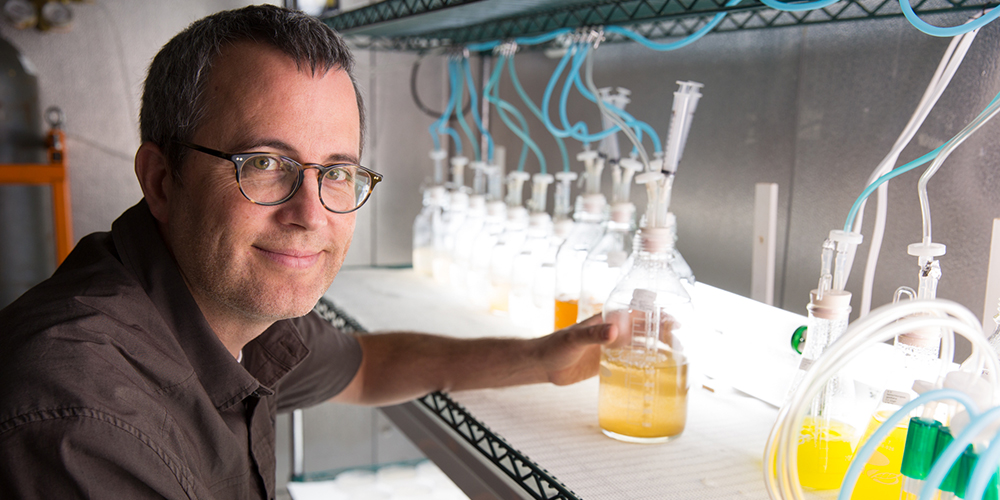Diatom species Epithemia. Diatoms are a large group of microscopic algae that grow as single cells or small colonies. Photo by Mark B. Edlund, courtesy of the National Science Foundation.
Evolutionary biologist Andrew Alverson likes to borrow an insight from his old Ph.D. advisor, who calls diatoms the most important little organisms that most people have never heard of.
Diatoms are one of the world’s most diverse groups of microalgae. They’re tiny – a dozen or more of them could fit on the head of a pin. They are found in oceans, lakes, and rivers – practically anywhere there is moisture and sunlight. They’re also prolific photosynthesizers, producing one-fifth of earth’s oxygen, and are a key component of ocean food webs.
With an estimated 100,000 species, diatoms represent a diverse lineage in the tree of life, said Alverson, assistant professor in the Department of Biological Sciences.
“Diatoms are about as diverse as flowering plants,” Alverson said. “But the vast majority of diatom species haven’t been described or characterized, so we don’t know anything about them or their biology. They fall into a vast category of unknown microbial diversity that is sometimes referred to as ‘microbial dark matter’.”
To date, researchers have sequenced genomes from a handful of diatoms. Alverson and his colleagues sequenced full genomes for a few additional species, and sequenced transcriptomes – the parts of the genome that encode for genes – for 200 more. They used those data to reconstruct the phylogeny, or family tree, of diatoms. Alverson and his colleagues recently discovered that diatom genomes periodically double in size, an exciting discovery that they plan to pursue in upcoming research. Whole-genome duplications can lead to the formation of new species and new traits.
In 2016, Alverson was one of four researchers nationwide selected as an Early Career Investigator in Marine Microbial Ecology and Evolution. His project, supported by a $540,000 grant from the Simons Foundation, focuses on a single diatom species – Skeletonema marinoi – that began life in the ocean and was carried inland when the Baltic Sea formed following glacial erosion some 10,000 years ago.
The Baltic Sea is brackish, meaning it is saltier than fresh water but not as salty as seawater. Alverson is working with collaborators at the University of Gothenburg, Finnish Environment Institute, and Indiana University to determine how this diatom adapted to low salinity in such a short period of time. The results will help show how quickly diatoms can adapt to freshening of large parts of the ocean, near melting polar ice caps, for example

Andrew Alverson, an assistant professor in the Department of Biological Sciences, in his lab. Photo by Russell Cothren.
Alverson is also interested in how diatoms can tell a broader story about evolutionary adaptation. In July 2017, he received a National Science Foundation Early Career Development (CAREER) award to investigate one of the most fundamental questions in evolutionary biology: How do organisms adapt to a new or changing environment? He’ll do molecular genetic studies and lab experiments for 35 different diatom species to determine how easy, or hard, it is for ancestrally marine diatoms to colonize and diversify in freshwaters.
Diatoms offer a unique opportunity to study this question because they’ve made the transition from oceans to freshwater many times. “Are there multiple solutions to the problem?” he said. “Or have different groups found different ways to make the transition from marine to fresh waters? There could be a single solution, and if the organism doesn’t happen upon it, then it’s just out of luck.”
The findings will have implications beyond diatoms themselves. “You can ask the same set of questions to see how any organism adapts to any environmental change,” he said.
Alverson received $1.11 million for his five-year CAREER award. The CAREER program rewards excellence in research, teaching, and outreach among junior faculty, and is one of the NSF’s most prestigious awards. To satisfy the outreach requirement, Alverson plans to involve citizen scientists in an effort to identify and catalog diatoms from water bodies that may have never been sampled before. “The great thing about diatoms is that collect tens of thousands of diatoms by just filling a Gatorade bottle with whatever water you happen to be near,” he said. His goal is to receive and analyze hundreds of water samples sent in from around the United States. A project website will allow contributors to learn about the ecology of their water body based on the diatoms found there.
Cells of Glass
In addition to their importance ecologically, diatoms are notable for their beautiful cell walls. They are made out silica, which is essentially glass.
“They are one of a very few organisms that make their cell wall this way,” Alverson said. “Scientists have marveled at their ornate glass walls since the late 18th century. They produce these cell walls on the nano scale, replicating their intricate patterns with really high fidelity. There is a lot of interest in finding out how they do this so that we could use them to make computer chips, for example.”
Alverson didn’t grow up with a goal to study microalgae. “What kid grows up wanting to study something you can’t see?” he asks. Indeed, Alverson spent five years studying flowering plants as a post-doctoral researcher. But he’s excited about the potential discoveries in diatoms, which are both incredibly diverse and not nearly as well studied as plants.
“People now understand that most of Earth’s biodiversity is microscopic,” he said. “Diatoms are beautiful and abundant. All of this diversity is unexplored and there is something inherently exciting about charting new territory.”
Alverson’s research is also funded by the Gordon and Betty Moore Foundation and the Arkansas Biosciences Institute.
Additional reporting by Bob Whitby



